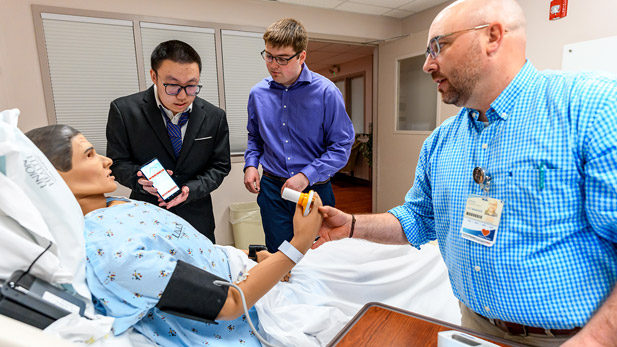Students Apply Skills to Develop Local Health Care Tools

Mechanical engineering, computer science, and software engineering students spend their senior year creating a car simulation tool and Hospital at Home app for Union Health’s physical and respiratory therapy laboratories.
Two student teams have developed mechanical and web-based devices to help future patients of Terre Haute’s Union Health get better access to necessary care to recover from injuries and monitor their ever-changing health conditions.
These senior-year capstone projects allowed students to apply their knowledge and skills of engineering and computer science principles to solve real-world problems.
Union Hospital’s Physical Therapy Laboratory needed a new car simulator to supplement the recovery process for their patients. This large-scale device is used to replicate the entry and exit process of a vehicle for patients who are rehabilitating after suffering a stroke, having had hip replacement surgery, or recovering from similar health conditions. It is open on one side to allow therapists and other staff to help assist patients throughout the training process.
Union Health’s current simulator (originally created several years ago by a former Rose-Hulman student team) has become outdated, lacks sufficient interior space to accommodate all patients, and the height of the simulator is fixed.
Therefore, six mechanical engineering students developed a new, more spacious simulator, salvaged from a 1994 Ford Ranger, that can be safely adjusted to various heights by staff for use by 90% of patients needing care in making the transition to home life.
“The students’ work on this project is beyond my wildest expectations. They worked with us to provide us with an ideal simulator to help the needs of our patients. This will really make a difference for our patients,” said Neely Quist-Zoheide, site coordinator of Union Heath’s medical rehabilitation unit. She estimates that as many as 15 patients may use the device weekly once it is set up later this summer.
The project, supported by the Union Health Foundation grant, earned a red ribbon honor as one of the top mechanical engineering projects completed this year. It also was a finalist for the William A. Kline Innovation Award as Best of Show at this year’s Rose Show, an event near the end of the 2023-24 school year that showcased student projects.
However, knowing that the team was helping others was particularly important to 2024 graduate Zak Koehler, whose father had hip replacement surgery after being involved in a car accident.
“Seeing him through that recovery process and struggle to do small things like get off the couch or get in and out of a vehicle — that was a lot of what motivated me to do this project,” Koehler said. “We’ve learned so much … but there was a lot of trial and error and figuring out how certain things fit together. At the end, it’s great knowing that something that we created will be used by the public and will help people in their recovery process.”
Other students on the project development team were Naa Ashifia Anum, Mateen Afkhami, Nathan Dalton, Kaley Hart, and Kiley Hart.
Meanwhile, four students majoring in computer science, software engineering, and data science created the initial prototype of a Hospital at Home web application tool that can help keep track of patient’s vital signs and physical measurements without needing to be hospitalized. This medical information collected by MedM’s SDK connected devices (monitoring such items as weight, blood pressure, heart and respiratory rates, and pulse oximetry) can be transferred multiple times daily by Bluetooth technology to a doctor’s office, hospital, or other health care facility.
Jimmy McKanna, director of Union Health’s respiratory therapy department and Hospital at Home program, says that this constantly updated patient information is important to catch changes that may require immediate medical attention. Also, monitoring patients’ vital signs at home is important for patients living in rural areas and puts less stress on hospital bed usage, which became an issue during the public health pandemic.
Limiting in-patient hospital care also can provide substantial financial cost savings for insurance companies, the government Medicare/Medicaid health care coverage system, and patients who pay for their own health care services.
“This project works for our community and was built for what our patients need every day,” said McKanna. “It helps us monitor patient care while they aren’t in front of us. It provides us with another tool to assist us in providing better patient care.”
Working with McKanna and MedM provided students with valuable insight in a project’s development cycle, according to project leader Jacob Wallis, a 2024 computer science graduate.
“We learned to design software tools that were maintainable and useful for a client. We found software tools (through MedM) that could be incorporated into our project, saving a lot of development time and team resources. We worked hard to provide the best results to meet the client’s needs,” said Wallis.
MedM Chief Ecosystem Officer Victoria Krasilshikova added, “We are very excited to have MedM’s connected health technology used in this project, enabling Rose-Hulman students to have a practical hands-on learning experience with building a remote patient monitoring service. We are also delighted to see such early adopters as Union Health experimenting with the new possibilities of remote care.”
Joining Wallis on the project development team were Yuxuan Jiang, Ken Zheng, and Yunzhe Wei.
McKanna hopes to continue development of the Hospital at Home app by another Rose-Hulman computer science and software team during the 2024-25 school year.
“This year’s team made enormous strides and we can now see other opportunities for this project,” McKanna said.